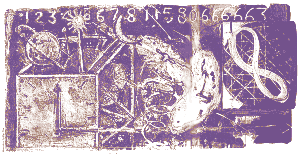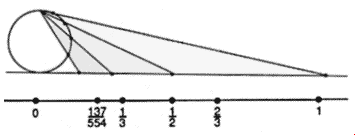

Chaos seems to provide a bridge between the deterministic laws of physics
and the laws of chance, implying that the Universe is genuinely creative
and that the notion of free will is real
Paul Davies

All science is founded on the assumption that the physical
world is ordered. The most powerful expression of this order is found in
the laws of physics. Nobody knows where these laws come from, nor why they
apparently operate universally and unfailingly, but we see them at work all
around us: in the rhythm of night and day, the pattern of planetary motions,
the regular ticking of a clock.
The ordered dependability of nature is not however, ubiquitous.
The vagaries of the weather, the devastation
of an earthquake, or the fall of a meteorite seem to be arbitrary and fortuitous.
Small wonder that our ancestors attributed these events to the moodiness
of the gods. But how are we to reconcile these apparently random
"acts of God" with the supposed
underlying lawfulness of the Universe?
The ancient Greek philosophers regarded the world as a battleground
between the forces of order, producing cosmos, and those of disorder,which
led to chaos. They believed that random or disordering
processes were negative, evil influences. Today, we don't regard the role
of chance in nature as malicious, merely as blind. A chance event may act
constructively, as in biological evolution, or destructively, such as when
an aircraft fails from metal fatigue.
Though individual chance events may give the impression of
lawlessness, disorderly processes, as a whole, may still display statistical
regularities. Indeed, casino managers put as much faith in the laws of chance
as engineers put in the laws of physics. But this raises something of a paradox.
How can the same physical processes obey both the laws of physics and the
laws of chance?
Following the formulation of the laws of mechanics
by Isaac Newton
in the 17th century, scientists became accustomed to thinking of the Universe
as a gigantic mechanism. The most extreme form of this doctrine was strikingly
expounded by Pierre
Simon de Laplace in the 19th century. He envisaged every particle of
matter as unswervingly locked in the embrace of strict mathematical laws
of motion. These laws dictated the behaviour of even the smallest atom in
the most minute detail. Laplace argued that, given the state of the Universe
at any one instant, the entire cosmic future would be uniquely fixed, to
infinite precision, by
Newton's
laws.
The concept of the Universe as a strictly deterministic machine
governed by eternal laws profoundly influenced the scientific world view,
standing as it did in stark contrast to the old
Aristotelian picture of the cosmos as
a living organism. A machine can have no
"free will"; its future is rigidly determined
from the beginning of time. Indeed, time ceases to have much physical
significance in this picture, for the future is already contained in the
present. As Ilya
Prigogine, a theoretical chemist at the University of Brussels, has
eloquently expressed it, God is reduced to a mere archivist, turning the
pages of a cosmic history book that is already written.
Implicit in this somewhat bleak mechanistic picture was the
belief that there are actually no truly chance processes in nature. Events
may appear to us to be random but, it was reasoned, this could be attributed
to human ignorance about the details of the processes concerned. Take,
for example, Brownian
motion. A tiny particle suspended in a fluid can be observed to execute
a haphazard zigzag movement as a result of the slightly uneven buffeting
it suffers at the hands of the hands of the fluid molecules that bombard
it.Brownian motion is the archetypical random, unpredictable process. Yet,
so the argument ran, if we could follow in detail the activities of all the
individual molecules involved, Brownian motion would be every bit as predictable
and deterministic as clockwork. The apparently random motion of the Brownian
particle is attributed solely to the lack of information about the myriads
of participating molecules, arising from the fact that our senses are too
coarse to permit detailed observation at the molecular level.
For a while, it was commonly believed that apparently
"chance" events were always the result of our ignoring, or effectively
averaging over, vast numbers of hidden variables, or degrees of freedom.
The toss of a coin or a die, the spin of
a roulette wheel-these would no
longer appear random if we could observe the world at the molecular level.
The slavish conformity of the cosmic machine ensured that lawfulness was
folded up in even the most haphazard events, albeit in an awesomely convoluted
tangle.
Two major developments of the 20th century have, however, put
paid to the idea of a clockwork universe. First there was
quantum mechanics. At the heart of quantum physics
lies Heisenberg's uncertainty principle,
which states that everything we can measure is subject to truly random
fluctuations. Quantum fluctuations are not the result of human limitations
or hidden degrees of freedom; they are inherent in the workings of
nature on an atomic scale. For example, the exact moment of decay of
a particular radioactive nucleus is intrinsically uncertain. An element
of genuine unpredictability is thus injected into nature.
Despite the uncertainty principle, there remains a sense
in which quantum mechanics is still a deterministic theory. Although
the outcome of a particular quantum process might be undetermined, the relative
probabilities of different outcomes evolve in a deterministic manner. What
this means is that you cannot know in any particular case what will be the
outcome of the "throw of the quantum dice" but you can know completely accurately
how the betting odds vary from moment to moment. As a statistical theory,
quantum mechanics remains deterministic. Quantum physics thus builds chance
into the very fabric of reality, but a vestige of the Newtonian-Laplacian
world view remains.
Along came chaos
Then along came chaos. As the previous articles in this series have discussed,
the essential ideas of chaos were already present in the work of the
mathematician Henri
Poincaré at the turn of the century, but it is only in recent
years, especially with the advent of fast electronic computers, that people
have appreciated the full significance of chaos theory.
The key feature of a chaotic process concerns the way that
predictive errors evolve with time. Let me first give an example of a non-chaotic
system: the motion of a simple pendulum. Imagine two identical pendulums
swinging in exact synchronism. Suppose that one pendulum is slightly disturbed
so that its motion gets a little out of step with the other pendulum. This
discrepancy, or phase shift, remains small as the pendulums go on swinging.
Faced the task of predicting the motion of a simple pendulum,
one could measure the position and velocity of the bob at some instant, and
use Newton's laws to compute the subsequent behaviour. Any error in the initial
measurement propagates through the calculation and appears as an error in
the prediction. For the simple pendulum, a small input error implies a small
output error in the predictive computation. In a typical non-chaotic system,
errors accumulate with time. Crucially, though, the errors grow only in
proportion to the time (or perhaps a small power thereof), so they remain
relatively manageable.
Now let me contrast this property with that of a chaotic system.
Here a small starting difference between two identical systems will rapidly
grow. In fact, the hallmark of chaos is that the motions diverge exponentially
fast. Translated into a prediction problem, this means that any input error
multiplies itself at an escalating rate as a function of prediction time,
so that before long it engulfs the calculation, and all predictive power
is lost. Small input errors thus swell to calculation-wrecking size in very
short order.

The distinction between chaotic and non-chaotic behaviour is
well illustrated by the case of the spherical pendulum, this being a pendulum
free to swing in two directions (see New Scientist, "Chaos in the swing of
a pendulum", 24 July 1986). In practice, this could be a ball suspended on
the end of a string. If the system is driven in a plane by a periodic motion
applied at the pivot, it will start to swing about. After a while, it may
settle into a stable and entirely predictable pattern of motion, in which
the bob traces out an elliptical path with the driving frequency. However,
if you alter the driving frequency slightly, this regular motion may give
way to chaos, with the bob swinging this way and then that, doing a few clockwise
turns, then a few anticlockwise turns in an apparently random manner.
The randomness of this system does not arise from the effect
of myriads of hidden degrees of freedom. Indeed, by modelling mathematically
only the three observed degrees of freedom (the three possible directions
of motions), one may show that the behaviour of the pendulum is nonetheless
random. And this is in spite of the fact that the mathematical model concerned
is strictly deterministic.
It used to be supposed that determinism went hand in hand with predictability,
but we can now see that this need not be the case. A deterministic system
is one in which future states are completely determined, through some dynamical
law, by preceding states. There is thus a one-to-one association between
earlier and later states. In computational terms, this suggests a one-to-one
association between the input and the output of a predictive calculation.
But now we must remember that any predictive computation will contain some
because we cannot measure physical quantities to unlimited precision. Moreover,
computers can handle only finite quantities of data anyway.
 |
The situation is represented geometrically in Figure above.
The fan of straight lines establishes a one-to-one correspondence between
points on the arc of the circle and points on the horizontal line. In the
idealised case of perfect geometrical forms consisting of infinitesimally
thin continuous lines and points of zero size, this correspondence is meaningful.
But no real geometrical forms can be like this. As the top of the circle
is approached, so points from a smaller and smaller arc are associated with
a bigger and bigger segment of the horizontal line. (Think of points near
the top of the arc as analogous to the initial conditions of a chaotic system,
and points towards the right of the horizontal line as predicted values at
later and later times.) The slightest uncertainty about one's position on
the arc leads to a huge uncertainty about the corresponding point on the
line segment. De one-to-one association becomes smudged into
meaninglessness.
We might call this the fiction of the real line. The Ancient
Greeks realised that points on a line could be labelled by numbers, according
to their distance from one end. The Figure above shows a segment from 0 to
1. Fractions, such as 2/3 and 137/554, could be used to label the points
in between. The Greeks called these numbers
"rational" (as in ratio). By
using enough digits in the numerators and denominators we can choose a fraction
that marks a place arbitrarily close to any designated point on the line.
Nevertheless, it is readily shown that continuous line segments cannot have
all their points labelled this way. That requires not only all possible rational
numbers, but all irrational
numbers too. An irrational number cannot be expressed as one whole number
divided by another. It may instead be expressed as a decimal, with an infinite
number of digits.
The set of all rational and irrational numbers form what
mathematicians call the real numbers,
and they underlie almost all modern theories of physics. The very notion
of continuous mechanical processes, epitomised by Newton's calculus which
he formulated to describe them, is rooted in the concept of real numbers.
Some real numbers, such as 1/2 = 0.5 or 1/3 = 0.3333..., can be expressed
compactly. But a typical real number has a decimal expansion consisting of
an infinite string of digits with no systematic pattern to it, in other words,
it is a random sequence (New Scientist, "A random
walk in arithmetic", 24 March 1990). It follows that to specify such
a number involves an infinite quantity of information. This is clearly
impossible, even in principle. Even if we were to commandeer the entire
observable Universe and employ it as a digital computer, its information
storage capacity would be finite. Thus, the notion of a continuous line described
by real numbers is exposed as a mathematical fiction.
Now consider the consequences for a chaotic system. Determinism
implies predictability only in the idealised limit of infinite precision.
In the case of the pendulum, for example, the behaviour will be determined
uniquely by the initial conditions. The initial data includes the position
of the bob, so exact predictability demands that we must assign the real
number to the position that correctly describes the distance of the bob 's
centre from a fixed point- And this infinite precision is, as we have seen,
impossible.

In a non-chaotic system this limitation is not so serious because
the errors expand only slowly. But in a chaotic system errors grow at an
accelerating rate. Suppose there is an uncertainty in, say, the fifth significant
figure, and that this affects the prediction of how the system is behaving
after a time, t. A more accurate analysis might reduce the uncertainty to
the tenth significant figure. But the exponential nature of error growth
implies that the uncertainty now manifests itself after a time 2t. So a
hundred-thousand-fold improvement in initial accuracy achieves a mere doubling
of the predictability span. It is this "sensitivity
to initial conditions" that leads to well-known statements about the
flapping of butterflies' wings in the Amazonian jungle causing a tornado
in Texas.
Chaos evidently provides us with a bridge between the laws
of physics and the laws of chance. In a sense, chance or random events can
indeed always be traced to ignorance about details, but whereas Brownian
motion appears random because of the enormous number of degrees of freedom
we are voluntarily overlooking, deterministic chaos appears random because
we are necessarily ignorant of the ultra-fine detail of just a few degrees
of freedom. And whereas Brownian chaos is complicated because the molecular
bombardment is itself a complicated process, the motion of, say, the spherical
pendulum is complicated even though the system itself is very simple. Thus,
complicated behaviour does not necessarily imply complicated forces or laws.
So the study of chaos has revealed how it is possible to reconcile the complexity
of a physical world displaying haphazard and capricious behaviour with the
order and simplicity of underlying laws of nature.
Though the existence of deterministic chaos comes as a surprise,
we should not forget that nature is not, in fact, deterministic anyway. The
indeterminism associated with quantum effects will intrude into the dynamics
of all systems, chaotic or otherwise, at the atomic level. It might be supposed
that quantum uncertainty would combine with chaos to amplify the unpredictability
of the Universe. Curiously, however, quantum mechanics seems to have a subduing
effect on chaos (New Scientist, "Quantum physics on the edge of chaos", 19
November 1987). A number of model systems that are chaotic at the classical
level are found to be non-chaotic when quantised. At this stage, the experts
are divided about whether
quantum chaos is possible, or how it
would show itself if it did exist. Though the topic will undoubtedly prove
important for atomic and molecular physics, it is of little relevance to
the behaviour of
macroscopic objects, or to the
Universe as a whole. What can we conclude about Laplace's image of a clockwork
universe? The physical world contains a wide range of both chaotic and
non-chaotic systems. Those that are chaotic have severely limited predictability,
and even one such system would rapidly exhaust the entire Universe's capacity
to compute its behaviour. It seems, then, that the Universe is incapable
of digitally computing the future behaviour of even a small part of itself,
let alone all of itself. Expressed more dramatically, the Universe is its
own fastest simulator.
This conclusion is surely profound. It means that, even accepting
a strictly deterministic account of nature, the future states of the Universe
are in some sense "open". Some people have seized on this openness to argue
for the reality of human free will. Others claim that it bestows upon nature
an element of creativity, an ability to bring forth that which is genuinely
new, something not already implicit in earlier states of the Universe, save
in the idealised fiction of the real numbers. Whatever the merits of such
sweeping claims, it seems safe to conclude from the study of chaos that the
future of the Universe is not irredeemably fixed. To paraphrase Prigogine,
the final chapter of the great cosmic book has yet to be written.
Paul Davis is professor of mathematical physics at the University of Adelaide, and author of The Cosmic Blueprint. This is the last feature in the New Scientist series on chaos. The series will be published as a book next year.
Further Reading Autonomy of Free will and Determinism with a view to the Ontological Interpretation of Quantum Physics - Iraj Jafarian PhD |
| Chaos | Quantum | Logic | Cosmos | Conscious | Belief | Elect. | Art | Chem. | Maths |